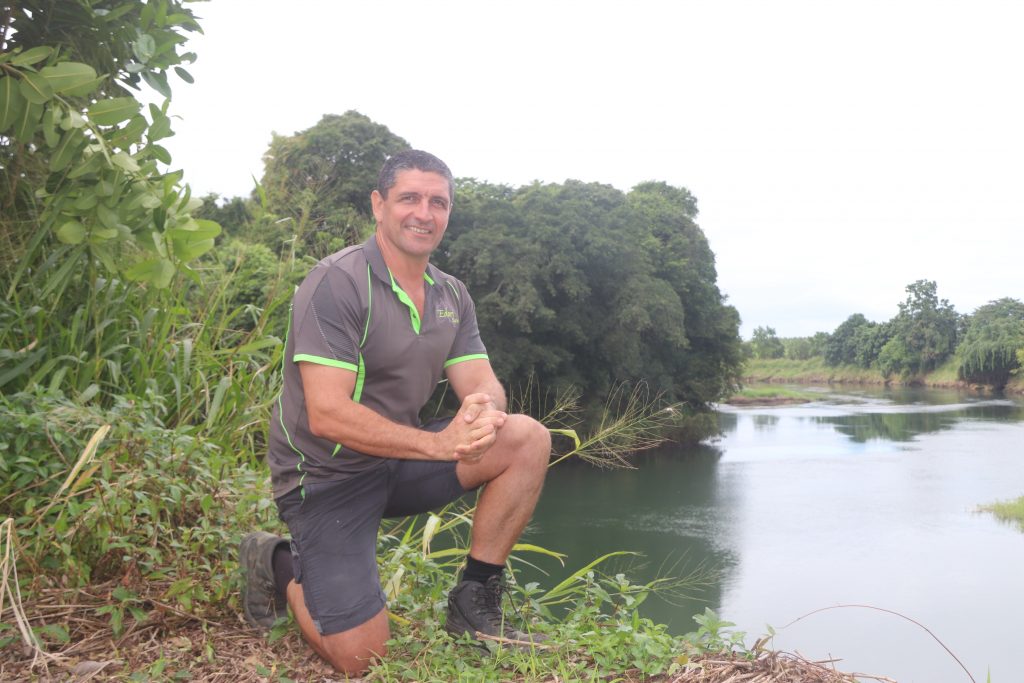
By Lea Coghlan
Just like farming, looking after the environment runs through Shayne Cini’s veins.
Together with wife Blaise and daughters Kari and Eden, the fourth-generation farmer grows bananas on 99.5 hectares on the banks of the South Johnstone River near Wangan, south of Innisfail in Far North Queensland.
The Cini family has an inter-generational connection with the river. Just as his father Danny did, and his grandfather Willy before him, Shayne has embarked on his own journey of continued environmental improvement, which has focussed primarily on riverbank stabilisation to repair badly eroded sections along the riverway which runs beside the property.
“There is so much pressure on growers to look after the environment and reduce sediment and nutrient losses and run-off from farms into the river system and ultimately, the Great Barrier Reef lagoon,” Shayne said.
“We see the loss of the riverbank as a major contributor of fine sediment to the river system, far greater than what we lose off farm.
“Restoring the riverbank helps the environment, but it also helps us farm sustainably and leaves this farm in the best possible position for the next generation.”
Shayne and Blaise recently secured an incentive grant through the BMP project, funded by the Office of the Great Barrier Reef, to stabilise a further 50m section of the riverbank.
Between 2020 and 2022, the Australian Banana Growers’ Council has $750,000 in BMP grants available to help growers change practices to better align their farming systems with recommended best practice. The grant will fund 75 per cent of this project. Shayne and Blaise will contribute the additional 25 per cent.
Shayne’s grandfather first started work to stabilise the riverbank and reduce erosion and sediment loss into the river more than 40 years ago. The new project is an extension of earlier works which Shayne estimates used some 6000 tonnes of rock. Work is scheduled to start later this year.
“We have already completed extensive riverbank erosion control measures over the past few years at two different locations on our property,” Shayne explained.
“The first site consisted of a rock wall, incorporating a spillway to direct farm runoff to a designated area in order to reduce erosion. The second lot of works were undertaken to protect an irrigation pump site and stabilise the existing riverbank also from further erosion.”
“This site consisted of a drain constructed to collect sediment moving off farm and direct the flow of farm runoff, stopping all riverbank erosion caused by runoff. Although the rock has prevented erosion, the riverbank continues to substantially subside further upstream.”
The new project will be managed by the Cassowary Coast River Improvement Trust and involve placing basalt rock at the bottom of the riverbed to stabilise the toe (the foundation) and gradually build up with rock. Once the bank is stabilised, it will be revegetated with suitable plant species.
Shayne and Blaise have embraced practice change in a number of areas on the farm. They manage farm runoff and sediment control through laser levelling paddocks, ground covered inter-rows, gravelled roadways and drainage. The crop is under drip irrigation, and all paddocks are fertigated at least weekly.
“The soil is one of our most important assets, so we believe putting measures in place to protect it is a logical approach,” Shayne said. “If everyone is serious about looking after the environment, projects like ours have got to be a good prevention.”
ABGC Best Practice Management Coordinator Amelia Foster said BMP projects were funded under a sliding scale, depending on who accrues the most benefit – the grower or the environment.
“Grants of up to $45,000 are currently on offer, with co-funding from the applicant, to assist growers to make on-farm improvements,” Mrs Foster said.
“There are growers who are changing their practices in line with the best management guidelines – making on-farm improvements like automated fertigation, building sediment control structures, improving drainage and purchasing slashers to increase ground cover.
“Funding is also available for innovative growers to undertake projects that will trial new ways of reducing nutrient and sediment loss and improve industry knowledge in this space.”
Mrs Foster said the project being delivered by Shayne and Blaise was significant for the benefits it will deliver to the environment.
